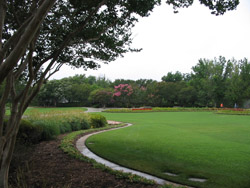Practical Turf Areas
In the water wise landscape turf plays a role where active
use of the area for recreation is anticipated. Turf areas provide paths through
out the landscape and properly chosen turf species with adequate soil depth
can be managed with minimal supplemental irrigation. Turf can also help
reduce soil erosion.
Turf areas should be
- Away from curbs or boundaries where waste due to overspray can occur,
- Located on level or minimally sloped areas to reduce runoff,
- Shaped in patterns which make it easy to design irrigation sprays, patterns,
or in shade where irrigation is less necessary
- Not be located in narrow strips between curbs, sidewalks and drive ways where
irrigation systems will overspray onto the hardscape.
- Have at least 8 inches of soil to ensure that there is an adequate soil water
reservoir.
These objectives can be achieved through programmatic approaches focused
on landscape design, or with ordinance approaches focused on width of irrigated
turf areas. The ordinance approach typically focuses on turf in median strips,
in buffer areas between sidewalks or driveways and the public right of way.
Median strips or buffers are often managed by municipal crews or homeowners
associations. The areas between the street and a hardscape such as a sidewalk
or driveway may also be located on property covered by an easement. Turf
areas that are on the interior of a property are not typically managed by
ordinance.
|
|
"...turf plays a role where active use of the area for recreation is anticipated."

Click to enlarge in separate window. |
|





